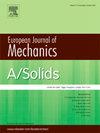Schwarzite-inspired hybrid cellular structures for energy absorption applications
IF 4.2
2区 工程技术
Q1 MECHANICS
引用次数: 0
Abstract
Inspired by Schwarzites, a novel hybrid cellular structure is proposed for energy absorption applications. The Schwarzite-inspired unit cell is reinforced by introducing a stiffener in its open region, which is further enhanced by incorporating an extruded geometry (referred to as an “extruder”) within the stiffener to maximize energy absorption. Structural optimization is carried out using quasi-static crush analysis, leading to the selection of the optimized unit cell 2 (UC2) for all subsequent studies. The impact resistance of the proposed unit cell is evaluated through bullet impact simulations, targeting pre-selected weak points on a sandwich structure composed of a UC2 core and Aluminum faceplates. This configuration demonstrates resistance to bullet velocities of up to 115 m/s at arbitrary impact locations. Subsequently, the Aluminum faceplates are replaced with carbon fiber reinforced polymer (CFRP) faceplates featuring various ply orientations. The use of CFRP results in a maximum reduction in bullet penetration depth of 17.81%. Among the different configurations, the [0/90/0/90] cross-ply orientation exhibits the least penetration depth and is therefore recommended. Finally, air blast simulations are conducted on sandwich structures incorporating cores made from UC2, bamboo spiderweb (BS), hierarchical honeycomb (HH), and stiffened honeycomb (SH) designs. Among these, the UC2 core exhibits the highest bending stiffness and the lowest back-face deflection, indicating uniform structural stiffness. Consequently, this design eliminates the need for multi-stage layering or strategic core offsetting.
受schwarzite启发的混合细胞结构的能量吸收应用
受Schwarzites的启发,提出了一种用于能量吸收的新型混合细胞结构。受schwarzite启发的单元电池通过在其开放区域引入加强筋来增强,通过在加强筋内结合挤压几何形状(称为“挤压器”)来进一步增强,以最大限度地吸收能量。使用准静态挤压分析进行结构优化,从而为所有后续研究选择优化的单元胞2 (UC2)。通过子弹冲击模拟评估了所提出的单元电池的抗冲击性,目标是由UC2核心和铝面板组成的夹层结构上预先选择的弱点。这种结构在任意撞击位置都能抵抗高达115米/秒的子弹速度。随后,铝面板被碳纤维增强聚合物(CFRP)面板取代,具有不同的厚度方向。CFRP的使用使子弹穿透深度最大减少了17.81%。在不同的配置中,[0/90/0/90]交叉层向的穿透深度最小,因此推荐使用。最后,对由UC2、竹蜘蛛网(BS)、分层蜂窝(HH)和加强蜂窝(SH)组成的夹层结构进行了空气爆炸模拟。其中UC2岩心的抗弯刚度最高,后面挠度最低,结构刚度均匀。因此,这种设计消除了多级分层或战略性核心抵消的需要。
本文章由计算机程序翻译,如有差异,请以英文原文为准。
求助全文
约1分钟内获得全文
求助全文
来源期刊
CiteScore
7.00
自引率
7.30%
发文量
275
审稿时长
48 days
期刊介绍:
The European Journal of Mechanics endash; A/Solids continues to publish articles in English in all areas of Solid Mechanics from the physical and mathematical basis to materials engineering, technological applications and methods of modern computational mechanics, both pure and applied research.

 求助内容:
求助内容: 应助结果提醒方式:
应助结果提醒方式:


